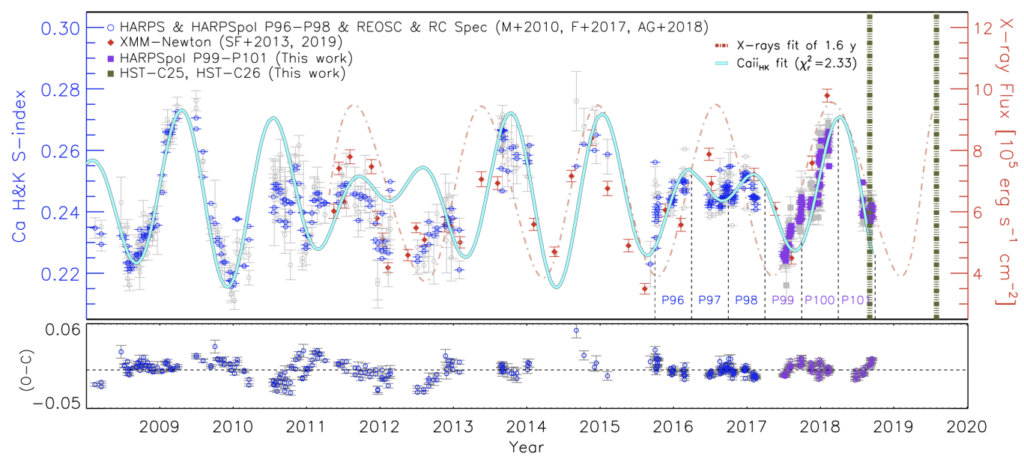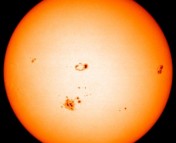Authors: E. M. Amazo-Gómez, J. D. Alvarado-Gómez, K. Poppenhaeger, G. A. J. Hussain, B. E. Wood, J. J. Drake, J.-D. do Nascimento Jr., F. Anthony, J. Sanz-Forcada, B. Stelzer, F. Del Sordo, M. Damasso, S. Redfield, J. F. Donati, P. C. König, G. Hébrard, P. A. Miles-Páez
First Author’s Institution: Leibniz-Institut für Astrophysik Potsdam, An der Sternwarte 16, 14482 Potsdam, Germany
Status: Published in MNRAS [closed access]
How well do we know stars other than the Sun?

Because – as far as astronomical distances are concerned – we are practically wrapped up in the Sun, we are acutely aware and able to easily observe its behavior in many different ways. We have the Solar Dynamics Observatory pointed at the Sun observing several portions of its electromagnetic radiation 24/7. There are satellites floating out there, like WIND and now Parker Solar Probe, tasked with literally getting a feel for the Sun’s wind. The point: we’ve had a stunning view of the Sun over a long period of time and to a great degree of time resolution. The same “quality and quantity” of data does not exist for any other star. Therefore, we are unable to assign as thorough physical prescriptions to other stars as we do the Sun without making significant assumptions about them. The authors of today’s paper are among many working to mediate this issue by obtaining high quality observations of a few typical stars over long timescales. Today’s paper focuses on the nearby and bright iota Horologii (ɩ Hor, see Figure 1).
The impact of this paper comes from the sheer amount of data the authors have taken and compiled on this one star, ɩ Hor. They used the HARPS instrument on the European Southern Observatory telescope in La Silla, Chile to obtain optical spectropolarimetric observations. This means they were able to observe ɩ Hor’s emission behavior in the visible portion of the spectrum, as well as its magnetic qualities. In addition, the authors compiled the data taken from space telescopes, such as TESS’s long photometric stares and the Hubble Space Telescope’s STIS ultraviolet spectra. Some of these observations occur at the same time as the optical ones. Having simultaneous multi-wavelength observations is powerful for astronomy because it places more constraints on the physics behind the emission behavior.
Polarimetry Side Quest
The authors were able to investigate the magnetic qualities of ɩ Hor using the polarimetry capabilities of HARPS. You may be asking: what is polarimetry? Good question. Light emitted from a magnetic object is manipulated by the magnetic properties of that object. Magnetic fields can polarize light, which is a fancy way of saying magnetic fields can act as filters, only letting light waves in a certain direction through. These changes are very specific to the magnetic fields, so monitoring the wave direction of light emitted can tell astronomers more about the magnetic properties of the object. For a guide to polarimetry, check out this Astrobite by Briley Lewis!
Why do we care to obtain polarimetry of a star? At a fundamental level, we do not fully understand the magnetic fields – their formation, behavior, and evolution – of stars. This is an important lack of understanding because magnetic fields impact the global picture of a star and how it changes with time. By obtaining lots of polarimetric data for a star, we are able to better characterize its magnetic properties and tie them to other activity indicators (e.g., emission from the different layers of the star).
Activity Indicators
With the HARPS optical spectra, the authors were able to track the behavior of a couple of “activity indicators” – spectral features within the star’s spectrum that trace magnetic activity (the stuff that causes spots, flares, faculae and all other sorts of lovely features that cover stars in beautiful blemishes). Two such indicators are the Ca II H&K lines and the H alpha line, both of which come from the star’s chromosphere. Observing the increase and decrease in emission at these specific wavelengths tells us something about the magnetic field dance that’s happening on the star’s surface up through its chromosphere. The authors plotted the Ca II H&K and H alpha behavior over time to figure out just how magnetically active ɩ Hor is and to see if these two features are correlated.
Long story short, Ca II H&K and H alpha are strongly correlated for ɩ Hor. This indicates that the magnetic activity at the different chromospheric layers where these lines are created are connected. Eventually, by monitoring activity indicators from different layers within the star’s atmosphere, its magnetism will be analyzed from root to crown!
With all this data, what are the authors able to say about ɩ Hor?
The power of this paper is not necessarily in its conclusions, but in its compilation of high quality and quantity data for one particular star (see Figure 2). This is the first necessary step in understanding the magnetic properties and activity of stars. The authors are preparing a future publication(s) using this data to thoroughly construct magnetic field maps of ɩ Hor. Those maps can then be used as inputs to coronal and stellar wind models that simulate the external environment the star creates – and the environment which exoplanets potentially inhabit.

Astrobite edited by Jessie Thwaites.
Featured image credit: NASA/SDO/AIA/LMSAL.




